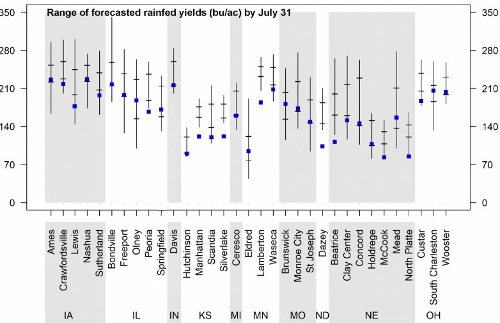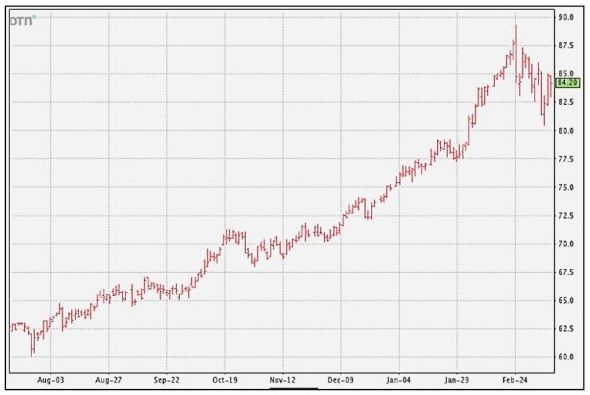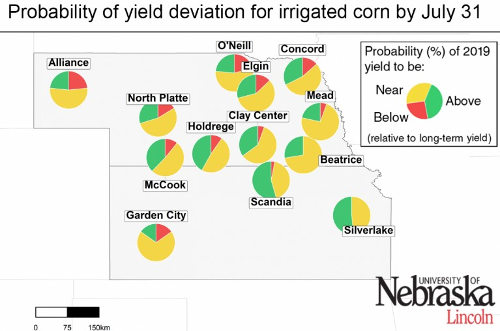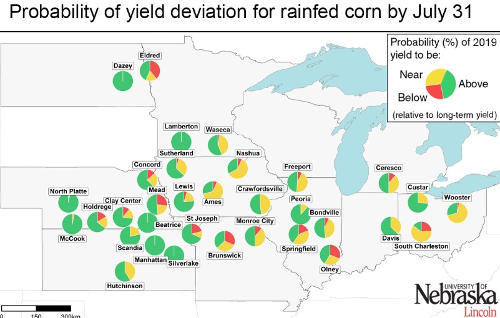By Patricio Grassini, Jose Andrade.et.al
This article summarizes the simulated crop stages and yield forecasts performed on July 31 for 37 locations across the US Corn Belt; the data can be
viewed here. Details on the underpinning methodology to simulate phenology and forecast end-of-season yields, as well as on interpretation and uses of yield forecasts, are described in a
previous article.
During the last two weeks, night temperature tended to be above normal in Iowa, Illinois, Indiana, and Ohio. Despite episodic heat waves, temperature has remained near normal in the other states. In the case of rainfall, most locations exhibited near-normal rainfall, except three sites in Kansas and portions of Illinois with rainfall below normal and some sites in Ohio, Minnesota, and North Dakota with above-normal rainfall. A summary of weather conditions during the last two weeks is shown in Figure 1.
The delay in crop development as a result of late planting has not translated into a high probability of
early frost damage at the majority of the sites in Iowa, Illinois, and Missouri. In contrast, the risk of early killing frost has increased compared with a normal year in northeastern Nebraska (Concord, O’Neill, and Elgin), western Nebraska (North Platte and Alliance), Minnesota, North Dakota, Ohio and the site in Indiana.
Figure 1. Daily solar radiation, maximum and minimum air temperature (Tmax and Tmin), total rainfall, and total reference grass-based evapotranspiration (ET) for the time period between July 15 and July 31, 2019. Vertical bars indicate the range for these variables based on 20+ years of weather records. The horizontal thick line indicates the long-term average and the red dots indicate the 2019 values.
Simulated Corn Stage across 37 Locations
Corn has reached silking stage across most of the Corn Belt, except for the eastern fringe where it is still in vegetative stages. As forecasted in the previous article, sites in Kansas, Missouri, and southern Nebraska, Iowa, and Illinois are well ahead of the rest of the locations, and corn is now between blister and dough stage (Figure 2). Overall, corn in the entire region is at an earlier developmental stage compared with the
previous 2018 crop season.
Figure 2. Simulated developmental stage for irrigated and rainfed corn at each location. R1: silking; R2: blister; R3: milk; R4: dough; R5: dent.
Irrigated Corn: Near Or Above-Average Yields
The range of forecasted irrigated corn yield potential for each location, as well as the probabilities for yields above, near, or below average, are shown in Figures 3 and 4 and in
Table 1. There is a relatively small chance (<25%; that is, a less than one in four) to have below-average yield potential across all irrigated sites. The chance of getting below-average yield is mostly associated with early-killing frost in the fall which, as mentioned previously, has increased in northeastern Nebraska. Weather during the rest of the season, especially temperature during the first two weeks of August, will determine if yields will ultimately be near or above average.


Figure 3. Vertical lines indicate the range of forecasted 2019 corn yield potential by July 31 for irrigated and rainfed corn based on average planting date in 2019 at each location. Horizontal lines indicate the 25th and 75th percentiles of the yield distribution (associated with respective adverse and favorable weather scenarios during the rest of the season). The blue squares indicates the long-term (2005-2018) average yield potential at each location.
Rainfed Corn: Low Probability of Below-average Corn Yields in 2019
Forecasted yield potential is highly variable across rainfed sites, but in general, the scenario looks favorable (Figures 3 and 4, Table 1). There is a high probability (>75%; that is, more than three out of four chances) of above-average yield at 10 sites, mostly located in Nebraska (three sites) and Kansas (three sites). The scenario is less clear for the other rainfed sites, although it seems that the chance of below-average yields is relatively low. Abundant and well distributed rainfall have determined a high probability to obtain near or above-average yields at many sites despite crop development running behind last year.


Figure 4. Probability of the 2019 yield potential to be below (<10%, red color), near (± 10%, yellow color), and above (>10%, green color) the long-term (2005-2018) average yield potential at each location. The larger a color section is within the pie chart, the higher the probability that end-of-season corn yield will be in that category.
Conclusions
Corn in most parts of the region has already reached the silking stage and is currently between the blister and dough stages in the southwestern fringe of the region (Nebraska, Kansas, and Missouri). Probability of early-killing frost during the fall has increased in many regions (northeastern Nebraska, North Dakota, Michigan, Minnesota, Indiana, and Ohio). For both rainfed and irrigated corn, there is a low probability of below-average yields at the majority of the sites. For rainfed corn, above-average yields are expected for nine locations, mostly located in Nebraska and Kansas. Temperature and rainfall during the rest of August will likely determine the trend for the other rainfed sites.
These forecasts do not take into consideration problems with stand emergence, hail/flooding damage, replanting situations, disease, or nitrate leaching. In fields negatively affected by these constraints, actual yields will be lower than estimates provided here. It is important to keep in mind that yield forecasts are not field specific and, instead, represent an estimate of average on-farm yield for a given location and surrounding area in absence of the yield-reducing factors mentioned here. Likewise, crop stages and forecasted yields will deviate from the ones reported here in fields with planting dates or hybrid maturities that differ markedly from those used as the
basis for the forecasts. We will follow up with further forecasts on August 20.